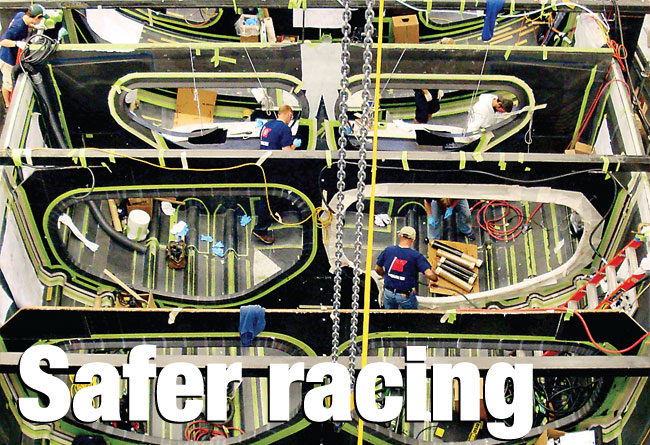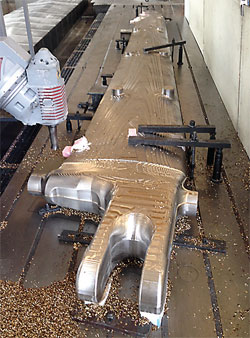

In pursuit of safer offshore structures. JASON SMITHWICK and HASSO HOFFMEISTER
As the world’s governing body, World Sailing (ISAF) believes that ensuring safety is one of our fundamental missions. The structural integrity of an offshore racing yacht is clearly imperative if that boat is to be genuinely self-sufficient and ready to meet any foreseeable emergency without outside assistance.
Formerly, all racing yachts needed to comply with a set of regulations developed by the technical committee of the Offshore Racing Congress (ORC) – the ABS Guide for Building and Classing Offshore Racing Yachts. In the past the American Bureau of Shipping (ABS) implemented these rules and carried out plan approval for race yachts up to 100ft.

Main picture: Brandon Linton’s build team ferret away inside the complex structure of Comanche at Hodgdon Yachts. At 100ft Comanche is the largest race monohull to be built in advanced composites in recent years – though François Gabart’s new G-100 tri Macif required more man-hours. Linton now runs the AC build team at Artemis.
Above: Commanche’s narrow keel spar is CNC-milled
But this was only the case up until 1996. Once European Directive EC95/25 for the CE-certification of pleasure craft was established that year, ABS ceased its activities. Subsequently it was left to yacht designers to confirm compliance with the ABS Rule; third-party review was no longer mandatory and only this designer declaration was required.
In the late noughties World Sailing set up a working group to investigate cases where sailing yachts had lost keels, sometimes with fatal consequences. The working group determined that a thirdparty assessment was indeed needed to inspect a yacht’s structural integrity, especially the keel and its attachment. As a consequence of these studies, Offshore Special Regulations were amended and for Offshore Special Regulations category 0, 1 and 2 events boats constructed, repaired or which underwent a major refit after 1 January 2010 are once again required to be structurally reviewed. Older boats that fulfil the current grandfathering regulations simply require a designer’s declaration.
Accreditation: Germanischer Lloyd (now DNV GL) was the first official body to sign up and assist World Sailing in establishing a framework for such third-party assessments. Since then six accredited bodies have been authorised to conduct mandatory structural plan reviews for the racing yacht sector. DNV GL currently enjoys the highest market share with this service.
Boats<24m: The OSR categorises boats according to size. An already existing structural standard was adopted for boats below 24m (79ft); this is the same standard as is used for the EU RCD directive (Recreational Craft Directive 94/25/EC), the CE-certification of regular pleasure yachts sold in the European market. The three parts of this ISO 12215 series standard that were chosen for compliance by racing yachts are ISO 12215 Part 5 (hull basic scantlings), Part 8 (rudders) and Part 9 (keels only).
Big boats: For boats greater than 24m World Sailing introduced a system where an IACS (International Association of Classification Societies) recognised body may conduct a plan review in accordance with their own rules. In 2009 World Sailing asked DNV GL to help develop a new structural code for larger yachts (>24m), based on DNV GL’s scantling rules. So far the following vessels have been reviewed using this scantling code: the three WallyCentos Hamilton (now Open Season), Magic Carpet3 and Galateia, all of the Volvo 65s, Perpetual Loyal 100, Rambler88, Beau Geste and Comanche – with several more to follow soon. GL DNV is also the designated plan review body for the TP52 and WallyCento class.
Repairs and refit: Newer boats built post-2010 are required to include a review by an accredited body when being repaired or modified. This in turn requires the review office to offer a fast response so that a racing team can quickly secure a new certificate. The team then present this to the race organiser to qualify for participation. The review certificate therefore reflects current structural condition and so must be signed by the builder, who is confirming that the yacht is built, modified or repaired according to the approved documentation.
Components typically included in a structural plan review
- Hull shell, deck shell, primary girders and stiffeners, frames, ring frames, bulkheads, decks, soles, integrated tanks, stern and transom, joining of primary structural components, global and local reinforcements
- Main engine foundations
- Structural details including window mullions, pillars, integral hatch panels, cut-outs, underwater recesses and hull penetrations
- Rudder including shaft, shaft bearings and structural integration
- Propeller bracket, including structural attachment and foundation
- Chainplates and mast step structure
- Keel arrangement, keel bulb, keel fin and its structural attachment to hull; hull structure in way of keel attachment
Typically excluded from plan review
- Lower priority foundations, such as anchor windlass, generators, pumps, safety equipment, mooring equipment
- Lower priority details such as access cover details, railings, mooring cleats, doors and non-integral hatches
- Watertight subdivision, closures and windows
- Strong points such as foundations for running rigging
- Physical proof/testing of composite materials used
Dr Jason Smithwick, Head of Technical & Offshore, World Sailing Hasso Hoffmeister, Senior Approval Engineer, DNV GL
Click here for more information on World Sailing »
We invite you to read on and find out for yourself why Seahorse is the most highly-rated source in the world for anyone who is serious about their racing.
To read on simply SIGN up NOW
Take advantage of our very best subscription offer or order a single copy of this issue of Seahorse.
Online at:
www.seahorse.co.uk/shop and use the code TECH20
Or for iPad simply download the Seahorse App at the iTunes store


